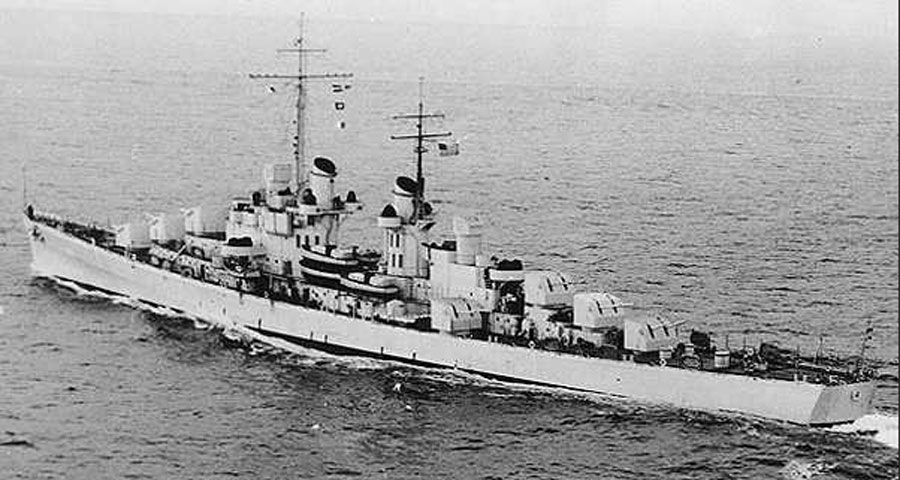
As posted yesterday, our project chapter member and co-founder of Project Baseline, Casey McKinley presented yesterday evening the documentary from their dive expedition to the USS Atlanta to a select audience with the Explorers Club.
The film offers a rare glimpse – if indeed ever filmed before – of the wreck as it rests at about 130 meters of depth. But the film also brings us visits today with some of the surviving crew members and their families, visits during which footage from the film is showed and events are recollected.
It’s a very touching moment for surviving crew members looking at this footage seeing the ship on which they served and seeing it now at the bottom of the sea, reminding them of fellow sailors and friends that were lost in 1942.
Here is part of the history of USS Atlanta, quoted from www.ussatlanta.com:
Atlanta was still off Lunga Point, screening the unloading, as part of TF 67 under Rear Admiral Daniel J: Callaghan in San Francisco. At about 1310, Atlanta received a warning that 25 enemy planes were headed for Guadalcanal, slated to arrive within 50 minutes. The light cruiser went to general quarters at 1318 and received the signal “prepare to repel air attack ….” Within six minutes, Atlanta and the other combatants of the support group formed a screen around the transport group (TG 67.1), and the two groups steamed north together at 15 knots. At about 1410, the Americans sighted the incoming raid, consisting of what appeared to be 25 twin-engined bombers (“Betties”) which broke up into two groups after clearing Florida Island, came in at altitudes that ranged from 25 to 50 feet. Juneau (CL-52) opened fire at 1412. Atlanta did so a minute later, training her guns at planes headed for the gap in the screen between San Francisco and the destroyer Buchanan (DD-484). Atlanta claimed to have shot down two “Betties” just after they dropped their torpedoes, at about 1415, only three minutes before the attack ended. Once the last Japanese plane had been splashed, the work of unloading the transports and cargo ships resumed. One “Betty,” crippled by antiaircraft fire, had crashed the after superstructure of San Francisco, inflicting the only damage on the force.
The abrupt end of the air attack gave Atlanta and her colleagues only a brief respite, however, for trouble approached from yet another quarter. A Japanese surface force, comprising two battleships, one cruiser and six destroyers, was detected steaming south toward Guadalcanal to shell Henderson Field-the airstrip on the island. Admiral Callaghan’s support group was to “cover [the retiring transports and cargo vessels] again enemy attack.” Accordingly, TG 67.4 departed Lunga Point about 1800 and steamed eastward through Sealark Channel, covering the withdrawal of TG 67.1. An hour before midnight, Callaghan’s ships reversed course and headed westward. Helena’s radar picked up the first contact on the Japanese ships at a range of 26,000 yards. As the range closed, Atlanta’s surface search radar, followed by her gunnery radars, picked up a contact on the enemy ships. Admiral Callaghan’s order for a course change to the left caused problems immediately, as Atlanta had to turn left immediately to avoid a collision with one of the four destroyers in the van-the latter having apparently executed a “ships left” rather than “column left” movement. As Atlanta began moving to resume her station ahead of San Francisco, the Japanese destroyer Akatsuki illuminated the light cruiser and fired torpedoes. Atlanta shifted her battery to fire at the enemy destroyer, opening fire at a range of about 1,600 yards. As two other Japanese destroyers crossed her line of Atlanta engaged both with her forward 5-inch mounts, while her after mounts continued to blast away at the illuminated ship. An additional, unidentified, assailant also opened up on the light cruiser from the northeast.
At about that time, at least one of Akatsuki’s torpedoes plowed into Atlanta’s forward engine room from the port side. She lost all but auxiliary diesel power, suffered the interruption of her gunfire, and had to shift steering control to the steering engine room aft. As if in retribution, Atlanta shot out Akatsuki’s searchlight, and the enemy ship; battered by San Francisco’s gunfire as well, sank with all hands.
Tragedy though, struck shortly thereafter. Soon alter her duel with Akatsuki ended, Atlanta reeled under the impact of a flurry of what was estimated as 19 8-inch hits when San Francisco, “in the urgency of battle, darkness, and confused intermingling of friend or foe” fired into her. Though almost all of the shells passed through the thin skin of the ship without detonating and scattered green dye throughout to mark their passage, fragments from their impact killed many men-including Admiral Scott and members of his staff. Atlanta prepared
to return fire on her new assailant, but San Francisco’s own gun flashes disclosed a distinctly “non-Japanese hull profile” that resulted in a suspension of those efforts. After the 8-inch fire ceased, Atlanta’s Capt. Jenkins took stock of the situation, and, miraculously having suffered only a minor (but painful) wound in his foot in the carnage forward, made his way aft to Battle II. Badly battered, largely powerless, down by the head and listing slightly to port, his ship had been badly hurt, and a third of his crew was dead or missing. As the battle continued in its waning stages, the light cruiser’s men set to work clearing debris, jettisoning topside weight to correct the list, reducing the volume of sea water in the ship, and succoring the many wounded.
Watching the film we are reminded of the people who endure great sacrifices so that we can enjoy the freedom we do. We are reminded that freedom does not come free
For us who love to dive, the footage from the dives shows us a proud wreck and offers us beautiful imagery with great visibility and light and we enjoy the skills portrayed by a team of great divers and are thankful of the producers who made the project possible. We are reminded also that we as divers can play an important role as documentors and explorers all while we do what do love to do – to dive.
Casey McKinley Presents Dive To The USS Atlanta

